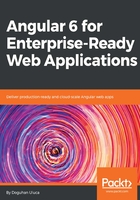
Conventions used
There are a number of text conventions used throughout this book.
CodeInText: Indicates code words in text, database table names, folder names, filenames, file extensions, pathnames, dummy URLs, user input, and Twitter handles. Here is an example: "Mount the downloaded WebStorm-10*.dmg disk image file as another disk in your system."
A block of code is set as follows:
{
"name": "local-weather-app",
"version": "0.0.0",
"license": "MIT",
...
When we wish to draw your attention to a particular part of a code block, the relevant lines or items are set in bold:
"scripts": {
"ng": "ng",
"start": "ng serve",
"build": "ng build",
"test": "ng test",
"lint": "ng lint",
"e2e": "ng e2e"
},
Any cross-platform or macOS specific command-line input or output is written as follows:
$ brew tap caskroom/cask
Windows specific command-line input or output is written as follows:
PS> Set-ExecutionPolicy AllSigned; iex ((New-Object System.Net.WebClient).DownloadString('https://chocolatey.org/install.ps1'))
Bold: Indicates a new term, an important word, or words that you see onscreen. For example, words in menus or dialog boxes appear in the text like this. Here is an example: "Launch the Start menu."
Warnings or important notes appear like this.
Tips and tricks appear like this.